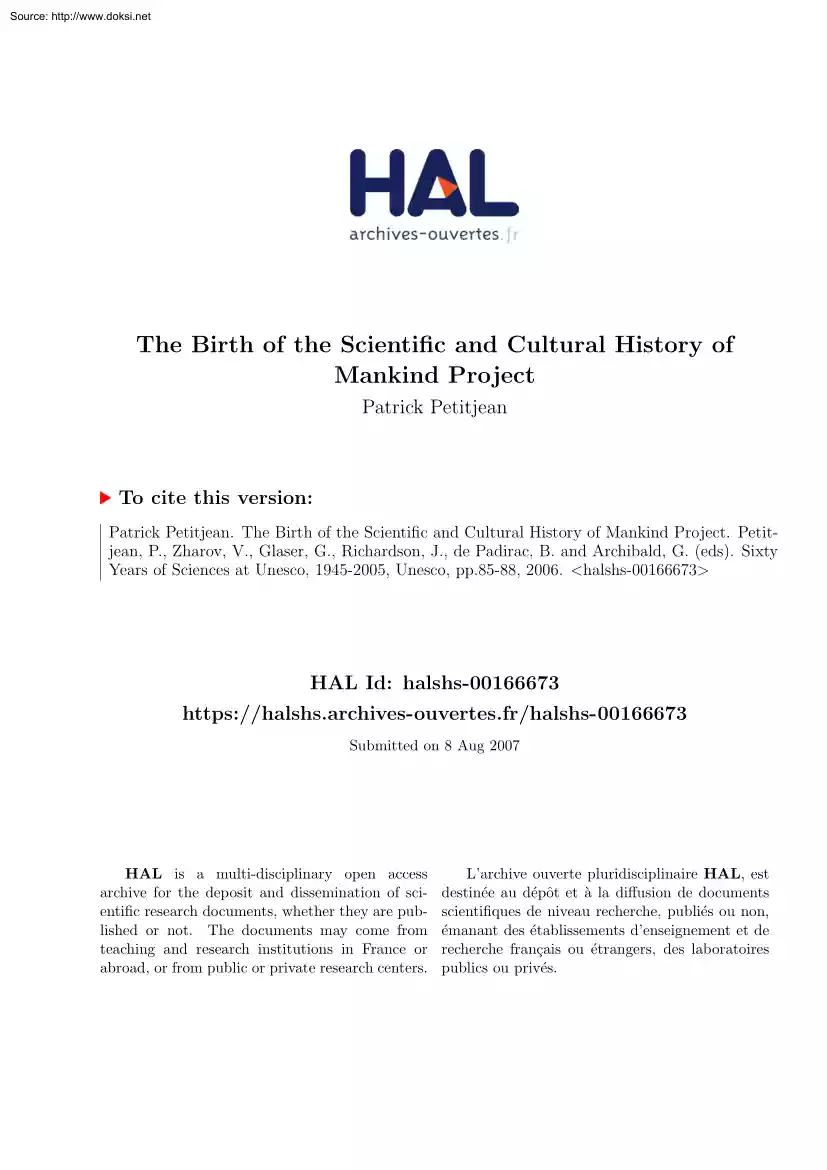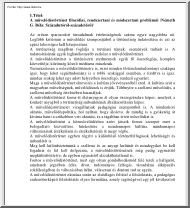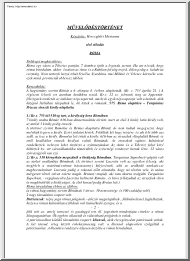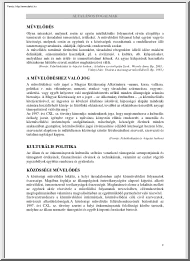Datasheet
Year, pagecount:2016, 3 page(s)
Language:English
Downloads:2
Uploaded:November 27, 2017
Size:1 MB
Institution:
-
Comments:
Attachment:-
Download in PDF:Please log in!
Comments
No comments yet. You can be the first!Most popular documents in this category
Content extract
Source: http://www.doksinet The Birth of the Scientific and Cultural History of Mankind Project Patrick Petitjean To cite this version: Patrick Petitjean. The Birth of the Scientific and Cultural History of Mankind Project Petitjean, P, Zharov, V, Glaser, G, Richardson, J, de Padirac, B and Archibald, G (eds) Sixty Years of Sciences at Unesco, 1945-2005, Unesco, pp.85-88, 2006 <halshs-00166673> HAL Id: halshs-00166673 https://halshs.archives-ouvertesfr/halshs-00166673 Submitted on 8 Aug 2007 HAL is a multi-disciplinary open access archive for the deposit and dissemination of scientific research documents, whether they are published or not. The documents may come from teaching and research institutions in France or abroad, or from public or private research centers. L’archive ouverte pluridisciplinaire HAL, est destinée au dépôt et à la diffusion de documents scientifiques de niveau recherche, publiés ou non, émanant des établissements d’enseignement et de
recherche français ou étrangers, des laboratoires publics ou privés. Source: http://www.doksinet THE ULTIMATE ODYSSEY The Birth of the "Scientific and Cultural History of Mankind" Project. Patrick Petitjean (REHSEIS – CNRS and Paris7 University) UNESCOs founders were nothing if not ambitious. At the Organizations second General Conference (Mexico, November-December 1947) they decided to embark on a project whose very title is breathtaking in its scope: a "Scientific and Cultural History of Mankind." Preparatory studies were launched to publish books for scientists as well as ordinary readers, "allowing a better comprehension of scientific and cultural dimensions of the history of humankind and showing the mutual dependency of peoples and cultures, and their respective contribution to humankind common patrimony." The main boosters of the project were Julian Huxley (UNESCOs first Director General), Joseph Needham (first head of UNESCO’s Natural
Sciences Section) and Lucien Febvre (French national Commission for the Organization). The project was initially nurtured by the Natural Sciences Section. It was entrusted to Armando Cortesao, who led the Departments History of Science division. Later, after the 3rd General Conference (Beirut, December 1948), it became a joint undertaking with the Cultural Activities Department. Armando Cortesao joined the "Philosophy and Civilizations" division, but kept the secretariat of the project until 1952. In his 1946 essay "UNESCO, Its Purpose and Its Philosophy," Huxley had proposed that a central task for the Organization would be "to help in constructing a history of the development of the human mind, notably in its highest cultural achievements" and claimed that "the development of culture in the various regions of the Orient must receive equal attention to that paid to its Western growth." His views were shared by Needham who, in October 1948,
offered an outline of his study "Science and Civilization in China" as part of the History. For Febvre, this project had to "show that, since time immermorial, men have met peacefully with other men, that they have communicated by exchanges and the borrowing of one another’s particular wealth, be it tools, technology, domesticated animals or improved plant specimens; that a network of peaceful relations has never ceased, through the ages, to cover a world that we want to see as permanently self-damaging; finally, that there are no insignificant peoples, no poor or destitute civilizations that have not had their glorious moments of invention, that have not contributed in one way or another to the building of our great and overconfident civilizations that, in fact, survive by borrowing."1 He believed that Westerners themselves demeaned their civilizations with colonialism and fascism: "Entire parts of this civilization have been unsettled, demeaned by the
Westerners themselves." Huxley, Needham and Febvre agreed that this History should not to be encyclopaedic nor mainly chronological. It was to be constructed around three basic hypotheses: exchanges of all kinds between civilizations are the driving force for the evolution of humankind; the exchanges of sciences and techniques among other cultural interactions are central to 1 Febvres Report of the Beyrouth Conference to the French National Commission. Notes et Études documentaires, n°1080, 26 February 1949, pp.9-13 Source: http://www.doksinet evolution; European civilization should not be considered the model, neither in the past nor in the future, for all civilizations. Modern civilization, as Huxley, Needham and Febvre saw it, was a joint construction of various cultures. Their views shaped a report produced by a team of experts meeting in December 19492. Needham summarized the result in a letter to Cortesao (14/01/1950): "After an opening part, introducing certain
fundamental knowledge about Man and the world in which he finds himself, there would be a second part describing the series of chronologically successive stages in the progress of humanity in social organisation and control over, and understanding of, Nature. The third part will be concerned with exchanges and transmissions in all branches of human knowledge, practice and experience; demonstrating the mutual indebtedness of all peoples, and bringing out the fact that there is no people or culture which has not contributed elements of essential value to the total human patrimony. The fourth part will outline the various patterns of the great cultures and civilisations, their particular worldoutlooks which were characteristic of them, and which, though not transmitted in former times, are now fusing into the world-picture of universal man. The fifth concluding part would be of a synthetic character. In so far as the attainment of perfect historical objectivity might be considered to be
impossible, the committee felt that emphasis might well be placed on the factors which have united mankind throughout history, rather than on those which have divided the various peoples." This orientation encountered opposition from traditional historians of science, especially in the United Kingdom. After the discussions of the British National Commission in Spring 1950, Febvre pointed out the source of difficulties: they were "due to the obstinacy with which so many representatives of so-called ‘European’ or ‘Western’ civilization regard the latter - their own - as the only true civilization."3 Nevertheless, the 5th session of the General Conference (Florence, June 1950) decided to undertake the publication of this History. UNESCO established an International Commission and an Editorial Committee, with a new group of scholars: Paulo Carneiro, a Brazilian biologist; Ralph Turner, an American historian; Guy Métraux, a Swiss sociologist; and Charles Morazé, a
French historian. They transformed the project, employing a more traditional, positivist and chronological approach. It became the history of the specific contributions of various civilisations to scientific and technological progress, rather than the history of mutual influences and exchanges. The "Scientific and Cultural History of Mankind" was not published until the 1960s, the sixth and final volume appearing in 1969. UNESCO published a completely revised edition in the 1980s, and is currently working on a third edition. If the finished product did not quite conform to the vision of Huxley, Needham and Febvre, it remains, nonetheless, a work of remarkable scholarly ambition. 2 The participants were Needham and Febvre - Rivet (Ethnologist, Paris) representing the ICPHS - Florkin (Biochemist, Liege) representing the ICSU - Ciasca (Historian, Genoa) - Shryock (Social Historian of Medicine, Johns Hopkins University) - Piaget (Sociologist and Psychologist, Geneva) – and
two historians of science, Cortesao and Pelseneer, representing Unescos Secretariat. 3 Letter from the French National Commission, 24 March 1950, to Unesco, in reaction to the project
recherche français ou étrangers, des laboratoires publics ou privés. Source: http://www.doksinet THE ULTIMATE ODYSSEY The Birth of the "Scientific and Cultural History of Mankind" Project. Patrick Petitjean (REHSEIS – CNRS and Paris7 University) UNESCOs founders were nothing if not ambitious. At the Organizations second General Conference (Mexico, November-December 1947) they decided to embark on a project whose very title is breathtaking in its scope: a "Scientific and Cultural History of Mankind." Preparatory studies were launched to publish books for scientists as well as ordinary readers, "allowing a better comprehension of scientific and cultural dimensions of the history of humankind and showing the mutual dependency of peoples and cultures, and their respective contribution to humankind common patrimony." The main boosters of the project were Julian Huxley (UNESCOs first Director General), Joseph Needham (first head of UNESCO’s Natural
Sciences Section) and Lucien Febvre (French national Commission for the Organization). The project was initially nurtured by the Natural Sciences Section. It was entrusted to Armando Cortesao, who led the Departments History of Science division. Later, after the 3rd General Conference (Beirut, December 1948), it became a joint undertaking with the Cultural Activities Department. Armando Cortesao joined the "Philosophy and Civilizations" division, but kept the secretariat of the project until 1952. In his 1946 essay "UNESCO, Its Purpose and Its Philosophy," Huxley had proposed that a central task for the Organization would be "to help in constructing a history of the development of the human mind, notably in its highest cultural achievements" and claimed that "the development of culture in the various regions of the Orient must receive equal attention to that paid to its Western growth." His views were shared by Needham who, in October 1948,
offered an outline of his study "Science and Civilization in China" as part of the History. For Febvre, this project had to "show that, since time immermorial, men have met peacefully with other men, that they have communicated by exchanges and the borrowing of one another’s particular wealth, be it tools, technology, domesticated animals or improved plant specimens; that a network of peaceful relations has never ceased, through the ages, to cover a world that we want to see as permanently self-damaging; finally, that there are no insignificant peoples, no poor or destitute civilizations that have not had their glorious moments of invention, that have not contributed in one way or another to the building of our great and overconfident civilizations that, in fact, survive by borrowing."1 He believed that Westerners themselves demeaned their civilizations with colonialism and fascism: "Entire parts of this civilization have been unsettled, demeaned by the
Westerners themselves." Huxley, Needham and Febvre agreed that this History should not to be encyclopaedic nor mainly chronological. It was to be constructed around three basic hypotheses: exchanges of all kinds between civilizations are the driving force for the evolution of humankind; the exchanges of sciences and techniques among other cultural interactions are central to 1 Febvres Report of the Beyrouth Conference to the French National Commission. Notes et Études documentaires, n°1080, 26 February 1949, pp.9-13 Source: http://www.doksinet evolution; European civilization should not be considered the model, neither in the past nor in the future, for all civilizations. Modern civilization, as Huxley, Needham and Febvre saw it, was a joint construction of various cultures. Their views shaped a report produced by a team of experts meeting in December 19492. Needham summarized the result in a letter to Cortesao (14/01/1950): "After an opening part, introducing certain
fundamental knowledge about Man and the world in which he finds himself, there would be a second part describing the series of chronologically successive stages in the progress of humanity in social organisation and control over, and understanding of, Nature. The third part will be concerned with exchanges and transmissions in all branches of human knowledge, practice and experience; demonstrating the mutual indebtedness of all peoples, and bringing out the fact that there is no people or culture which has not contributed elements of essential value to the total human patrimony. The fourth part will outline the various patterns of the great cultures and civilisations, their particular worldoutlooks which were characteristic of them, and which, though not transmitted in former times, are now fusing into the world-picture of universal man. The fifth concluding part would be of a synthetic character. In so far as the attainment of perfect historical objectivity might be considered to be
impossible, the committee felt that emphasis might well be placed on the factors which have united mankind throughout history, rather than on those which have divided the various peoples." This orientation encountered opposition from traditional historians of science, especially in the United Kingdom. After the discussions of the British National Commission in Spring 1950, Febvre pointed out the source of difficulties: they were "due to the obstinacy with which so many representatives of so-called ‘European’ or ‘Western’ civilization regard the latter - their own - as the only true civilization."3 Nevertheless, the 5th session of the General Conference (Florence, June 1950) decided to undertake the publication of this History. UNESCO established an International Commission and an Editorial Committee, with a new group of scholars: Paulo Carneiro, a Brazilian biologist; Ralph Turner, an American historian; Guy Métraux, a Swiss sociologist; and Charles Morazé, a
French historian. They transformed the project, employing a more traditional, positivist and chronological approach. It became the history of the specific contributions of various civilisations to scientific and technological progress, rather than the history of mutual influences and exchanges. The "Scientific and Cultural History of Mankind" was not published until the 1960s, the sixth and final volume appearing in 1969. UNESCO published a completely revised edition in the 1980s, and is currently working on a third edition. If the finished product did not quite conform to the vision of Huxley, Needham and Febvre, it remains, nonetheless, a work of remarkable scholarly ambition. 2 The participants were Needham and Febvre - Rivet (Ethnologist, Paris) representing the ICPHS - Florkin (Biochemist, Liege) representing the ICSU - Ciasca (Historian, Genoa) - Shryock (Social Historian of Medicine, Johns Hopkins University) - Piaget (Sociologist and Psychologist, Geneva) – and
two historians of science, Cortesao and Pelseneer, representing Unescos Secretariat. 3 Letter from the French National Commission, 24 March 1950, to Unesco, in reaction to the project





